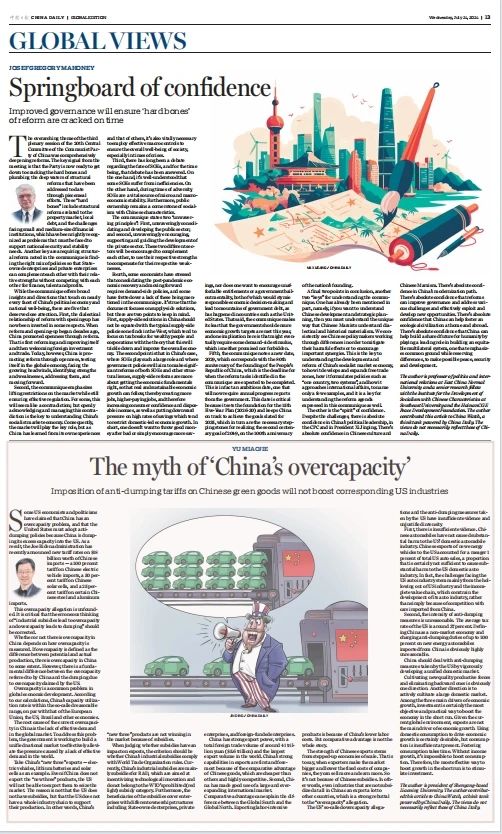2024年7月24日,中國日報(CHINA DAILY)發表了國際經濟學會會士,遼寧大學黨委副書記、校長余淼杰教授的文章《中國產能過剩之謎》。文章糾正了“產業補貼導致產能過剩,產能過剩導致傾銷”的錯誤觀念,指出中國的工業補貼符合世界貿易組織的規定,并強調中國出口優勢源于規模經濟和國際市場的擴展。文章建議中國應大力發展國內統一市場,以應對美國的貿易限制措施。原文如下:

The myth of 'China's overcapacity'
Imposition of anti-dumping tariffs on Chinese green goods will not boost corresponding US industries
YU MIAOJIE
July 24, 2024
Some US economists and politicians have claimed that China has an overcapacity problem, and that the United States must adopt anti-dumping policies because China is dumping its excess capacity into the US. As a result, the Joe Biden administration has recently announced new tariff rates on $18 billion worth of Chinese imports — a 100 percent tariff on Chinese electric vehicle imports, a 50 percent tariff on Chinese
solar cells, and a 25 percent tariff on certain Chinese steel and aluminum imports.
This overcapacity allegation is unfounded. It is critical that the erroneous thinking of "industrial subsidies lead to overcapacity and
overcapacity leads to dumping" should be corrected.
Whether or not there is overcapacity in China depends on how overcapacity is measured. If overcapacity is defined as the difference between potential and actual production, there is overcapacity in China to some extent. However, there is a fundamental difference between the
overcapacity referred to by China and the dumping due to overcapacity claimed by the US.
Overcapacity is a common problem in global economic development. According to our calculations, China's capacity utilization rate is
within the so-called reasonable range, on par with that of the European Union, the US, Brazil and other economies.
The root cause of the current overcapacity in China is the lack of effective demand in the global market. To address this problem, the
government is working to build a unified national market to effectively alleviate the pressure caused by a lack of effective demand in the
world.
Take China's "new three" exports — electric vehicles, lithium batteries and solar cells as an example. Even if China does not export the "new three" products, the US will not be able to export them to seize the market. The reason is not that the US does not have subsidies, but
that the US does not have a whole industry chain to support their production. In other words, China's "new three" products are not winning in the market because of subsidies.
When judging whether subsidies have an impact on exports, the criterion should be whether China's industrial subsidies comply with World
Trade Organization rules. Currently, China's industrial subsidies are mainly subsidies for R&D, which are aimed at incentivizing technological innovation and do not belong to the WTO's prohibited (red light) subsidy category. Furthermore, the beneficiaries of the subsidies cover
enterprises with different ownership structures including State-owned enterprises, private enterprises, and foreign-funded enterprises.
China has strong export power, with a total foreign trade volume of around 41 trillion yuan ($5.6 trillion) and the largest export volume in the world. China's strong capabilities in exports are first and foremost because of the comparative advantage of Chinese goods, which are
cheaper than others and highly competitive. Second, China has made good use of a large and ever-expanding international market. Comparative
advantage can explain the difference between the Global South and the Global North. Exporting labor-intensive products is because of China's
lower labor costs. But comparative advantage is not the whole story.
The strength of Chinese exports stems from stepped-up economies of scale. That is to say, when exporters make the market bigger and lower the fixed costs of companies, they can sell more and earn more. So it's not because of Chinese subsidies. In other words, even industries that are not subsidized at all in China can export a lot to other countries, which is a strong rebuttal to the "overcapacity" allegation.
The US' so-called overcapacity allegations and the anti-dumping measures taken by the US have insufficient evidence and unjustified intensity.
First, there is insufficient evidence. Chinese automobiles have not caused substantial harm to the US' domestic automobile industry.
Chinese exports of new energy vehicles to the US accounted for a meager 1 percent of total US auto sales, a proportion that is certainly not
sufficient to cause substantial harm to the US domestic auto industry. In fact, the challenges facing the US auto industry stem mainly from
the hollowing out of US industry and the incomplete value chain, which constrain the development of its auto industry, rather than simply
because of competition with cars imported from China.
Second, the intensity of anti-dumping measures is unreasonable. The average tax rate of the US is around 37 percent. Defining China as a
non-market economy and charging anti-dumping duties of up to 100 percent on new energy automobiles imported from China is obviously highly
unreasonable.
China should deal with anti-dumping measures taken by the US by vigorously developing a unified domestic market.
Cultivating new quality productive forces and eliminating backward ones is obviously one direction. Another direction is to actively
cultivate a large domestic market. Among the three main drivers of economic growth, investment is certainly the most objective and practical
way to boost the economy in the short run. Given the current global environment, exports are not the main driver of economic growth. Using
domestic consumption to drive economic growth is certainly desirable, but consumption is insufficient at present. Fostering consumption takes time. Without income growth, it's impossible to boost consumption. Therefore, the most effective way to boost growth in the short run is to
stimulate investment.
作者簡介
余淼杰,男,漢族,1976年生,教授,博士生導師,美國戴維斯加利福尼亞大學經濟學博士,現任第十四屆全國人大代表、國家監委特約監察員、遼寧省人大常委會委員、遼寧省人大立法委委員、遼寧大學黨委副書記、校長。是聯合國國際經濟學會(IEA)會士,長江學者特聘教授(2019年)、首屆青年長江學者(2015年)、國家杰青基金獲得者、北京市卓越青年科學家、北京大學博雅特聘教授、 商務部經貿政策咨詢委員、財政部“中美研究智庫聯盟”理事、俄羅斯伊爾庫茨克國立大學名譽教授、俄羅斯聯邦財政金融大學國際顧問理事。系中國世界經濟學會副會長、中國數量經濟學會副會長、中國工業經濟學會副理事長、全國港澳研究會副會長、遼寧省社科聯副主席、黃廷方/信和青年杰出學者、全球經管類前1%高引論文經濟學者,也是迄今為止唯一獲得“英國皇家經濟學獎”的華人學者。被聯合國、亞洲發展銀行、財政部、商務部、國務院參事室和多個地方政府聘為專家顧問,被專門邀請到聯合國總部做中國經濟發展報告。享受國務院政府特殊津貼。
余淼杰教授研究領域為國際貿易和中國經濟發展,曾在Economic Journal、Review of Economics & Statistics、Journal of International Economics、
Journal of Development Economics、《經濟研究》《管理世界》等國內外頂級、一流期刊上發表論文近二百篇,出版中英德文專著、教材、時評隨筆27部。任國際著名學術期刊Review of International Economics 副主編,商務部《國際貿易》名譽主編,《遼寧大學學報》主編、《日本研究》主編、《長安大學學報》執行主編。
曾獲得教育部哲學社科優秀成果獎(三次)、北京市哲學社科優秀成果獎、吳玉章人文社科研究獎、張培剛發展經濟學獎,安子介國際貿易研究獎(五次)。代表著作《加工貿易與企業生產率》獲劉詩白經濟學獎、胡繩青年學術研究獎、全國貿易發展研究獎、中國青年經濟學家獎、遼寧省哲學社會科學獎成就獎等。
在北大百廿校慶中,作為優秀中青年教師代表受到習近平總書記的專門接見。作為國家杰青25周年優秀代表參加時任國務院總理李克強主持的高規格座談會。
2024年作為全國人大青年代表團成員(共8名)訪問俄羅斯聯邦議會及地方杜馬。